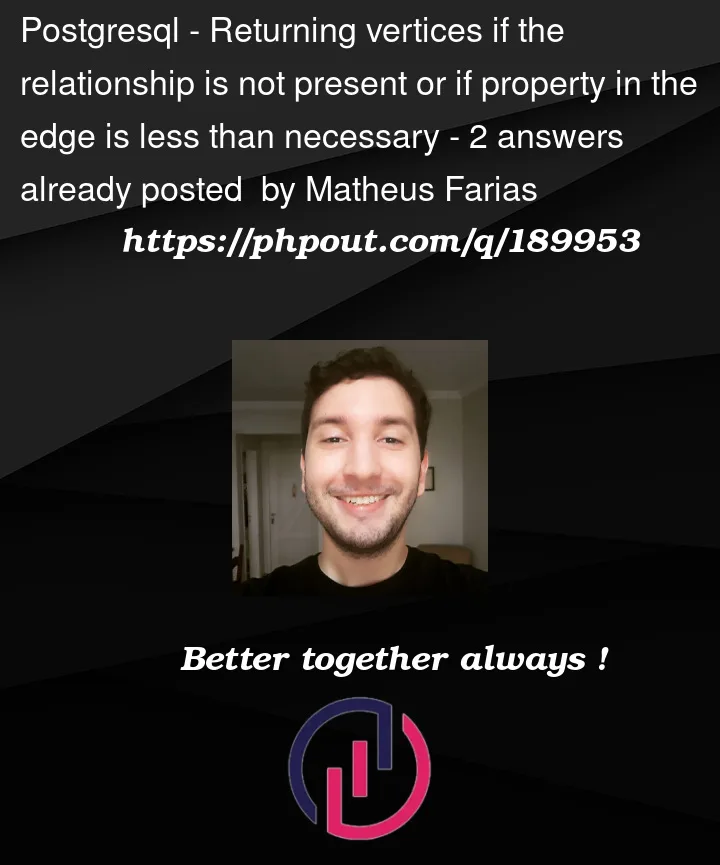I have created a graph to store LEGO products, the pieces of which each product requires, and the pieces that users already have. There are three labels for the vertices: Piece, Product, and User, and there are two labels for the edges: REQUIRES and OWNS. These vertices are connected in the following way:
(Product)-[REQUIRES {qty: int}]->(Piece {number: int})<-[OWN {qty: int}]-(User)
As an example, here’s the current graph that I’m creating:
-- Creating the graph.
SELECT * FROM ag_catalog.create_graph('LegoGraph');
-- Creating the product.
SELECT * FROM cypher('LegoGraph', $$
CREATE (v:Product {theme: 'Lego City', name: 'Police Patrol Car', number: 60239})
RETURN v.name, v.theme, v.number
$$) AS (name agtype, theme agtype, number agtype);
-- Specifying which pieces are required to build this product and their quantities.
SELECT * FROM cypher('LegoGraph', $$ MATCH (v:Product {number: 60239}) CREATE (v)-[:REQUIRES {qty: 2}]->(:Piece {number: 4504369}),
(v)-[:REQUIRES {qty: 2}]->(:Piece {number: 6213880}), (v)-[:REQUIRES {qty: 2}]->(:Piece {number: 6213881}), (v)-[:REQUIRES {qty: 1}]->(:Piece {number: 4179874}),
(v)-[:REQUIRES {qty: 1}]->(:Piece {number: 4179875}), (v)-[:REQUIRES {qty: 2}]->(:Piece {number: 4547489}), (v)-[:REQUIRES {qty: 6}]->(:Piece {number: 302301}),
(v)-[:REQUIRES {qty: 2}]->(:Piece {number: 6168612}), (v)-[:REQUIRES {qty: 4}]->(:Piece {number: 4259940}), (v)-[:REQUIRES {qty: 1}]->(:Piece {number: 243101}),
(v)-[:REQUIRES {qty: 1}]->(:Piece {number: 6023806}), (v)-[:REQUIRES {qty: 2}]->(:Piece {number: 4515359}), (v)-[:REQUIRES {qty: 1}]->(:Piece {number: 6031947}),
(v)-[:REQUIRES {qty: 2}]->(:Piece {number: 4560929}), (v)-[:REQUIRES {qty: 1}]->(:Piece {number: 4646574}), (v)-[:REQUIRES {qty: 2}]->(:Piece {number: 416201}),
(v)-[:REQUIRES {qty: 1}]->(:Piece {number: 6259271}), (v)-[:REQUIRES {qty: 1}]->(:Piece {number: 4159739}), (v)-[:REQUIRES {qty: 1}]->(:Piece {number: 4569056}),
(v)-[:REQUIRES {qty: 2}]->(:Piece {number: 302121}), (v)-[:REQUIRES {qty: 2}]->(:Piece {number: 242023}), (v)-[:REQUIRES {qty: 2}]->(:Piece {number: 301023}),
(v)-[:REQUIRES {qty: 2}]->(:Piece {number: 366623}), (v)-[:REQUIRES {qty: 2}]->(:Piece {number: 6188643}), (v)-[:REQUIRES {qty: 1}]->(:Piece {number: 6016165}),
(v)-[:REQUIRES {qty: 1}]->(:Piece {number: 6112622}), (v)-[:REQUIRES {qty: 1}]->(:Piece {number: 243224}), (v)-[:REQUIRES {qty: 1}]->(:Piece {number: 9553}),
(v)-[:REQUIRES {qty: 1}]->(:Piece {number: 6172536}), (v)-[:REQUIRES {qty: 1}]->(:Piece {number: 241226}), (v)-[:REQUIRES {qty: 4}]->(:Piece {number: 6029208}),
(v)-[:REQUIRES {qty: 2}]->(:Piece {number: 6199908}), (v)-[:REQUIRES {qty: 1}]->(:Piece {number: 4285883})
$$) AS (a agtype);
-- Creating an user.
SELECT * FROM cypher('LegoGraph', $$
CREATE (u:User {name: 'Bob'}) RETURN u.name
$$) AS (name agtype);
-- The pieces that he owns.
SELECT * FROM cypher('LegoGraph', $$
MATCH (u:User {name: 'Bob'}), (p:Piece {number: 4502089})
CREATE (u)-[:OWNS {qty: 4}]->(p)
$$) AS (a agtype);
SELECT * FROM cypher('LegoGraph', $$
MATCH (u:User {name: 'Bob'}), (p:Piece {number: 242023})
CREATE (u)-[:OWNS {qty: 2}]->(p)
$$) AS (a agtype);
SELECT * FROM cypher('LegoGraph', $$
MATCH (u:User {name: 'Bob'}), (p:Piece {number: 302301})
CREATE (u)-[:OWNS {qty: 2}]->(p)
$$) AS (a agtype);
What is the proper way to return the pieces (and their quantities) of a LEGO set that the user does not have yet, so that he/she can build it?




2
Answers
You can use
exists(path)predicate function to check whether a relationship exists or not. A sample query would be:or you want to CREATE the edges in the same query, then use something like
You can simply
MATCHfor the pieces required in a specified product and then useOPTIONAL MATCHfor the desired user to check, returning the piece IDs, quantity required, and the quantity owned.Result: